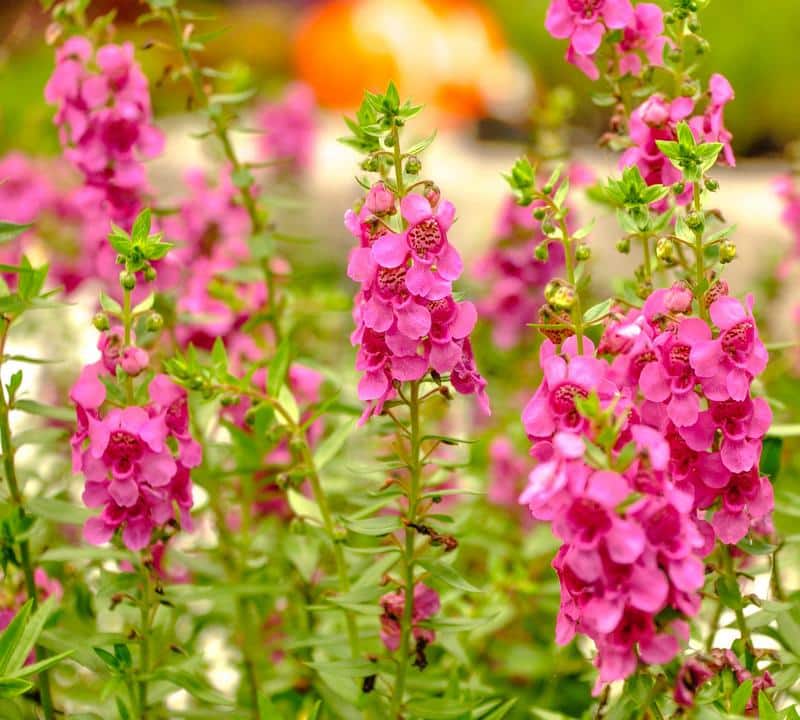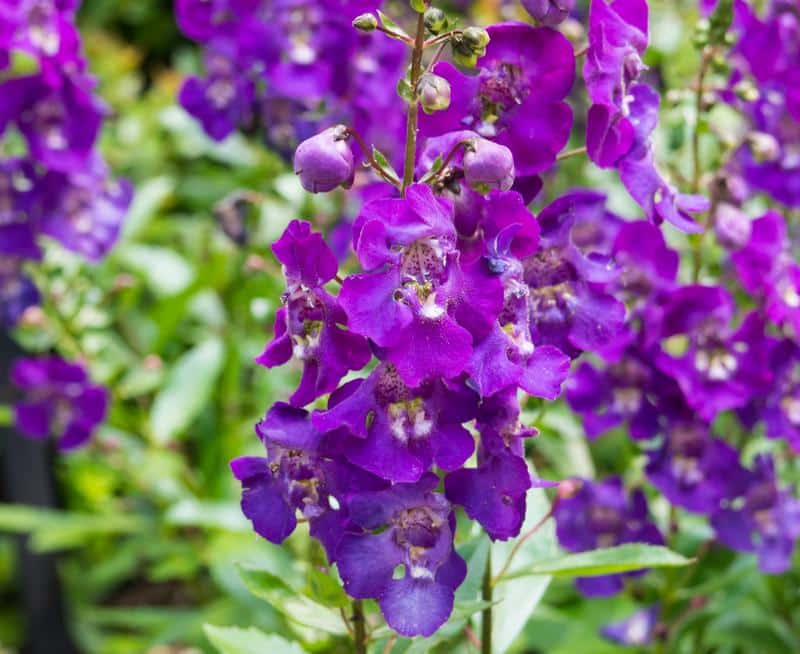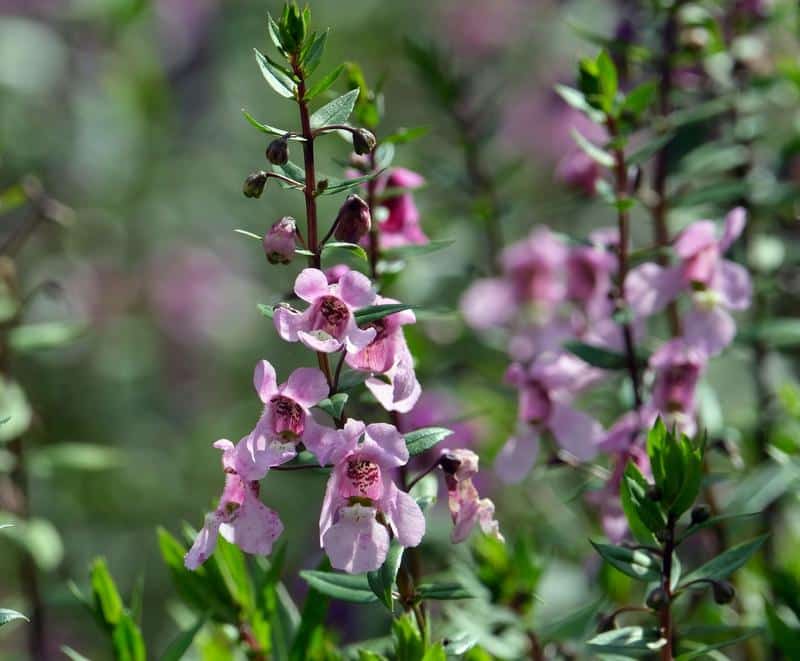Is Angelonia Toxic to Dogs? Is Angelonia Poisonous to Dogs?
Is Angelonia toxic to dogs? Is Angelonia poisonous to dogs? In this article, we’ll explain everything you need to know about if Angelonia is safe for dogs including what to do if your dog ate an Angelonia flower already. We’ll then go over the two commands that will ensure your dog behaves around Angelonia and other potentially toxic plants.
Next, we’ll teach you more things you should know about Angelonia and dogs, such as how to keep dogs away from Angelonia using barriers and other methods. Finally, we’ll instruct you on Angelonia flower care (annual or perennial, growing in pots, sun or shade, deer-resistant, zone, hardiness, water) and more to know when you have dogs. Keep reading!
Is Angelonia Toxic to Dogs?

Angelonia is not toxic to dogs. While it’s always wise to prevent dogs from chewing on any plants, Angelonia doesn’t pose a significant risk. That said, teaching commands like “leave it” and “drop it” can be beneficial to keep your pet from eating something potentially harmful.
Is Angelonia Poisonous to Dogs?
Angelonia is not poisonous to dogs. However, like with many non-toxic plants, it’s best to avoid allowing your dog to chew on them. Eating parts of the plant may lead to mild gastrointestinal discomfort, and also creates a potentially dangerous habit.
Teach the “Leave It” Command
Training your dog to obey the “leave it” command can be crucial in preventing them from picking up or eating something they shouldn’t. Here’s a brief explanation of how to train this command:
- Hold a treat in your closed hand and present it to your dog without letting them take it.
- Wait for your dog to withdraw from your hand and say “leave it.”
- Reward your dog with a different treat from your other hand as soon as they obey.
- Repeat this process, gradually increasing the difficulty by placing treats on the floor and using the command.
Teach the “Drop It” Command
Training the “drop it” command is similarly vital, especially if your dog has already picked up something they shouldn’t have. Here’s how to train this command:
- Start by playing a tug game with a toy your dog likes.
- Use a treat to entice your dog to drop the toy, saying “drop it.”
- When your dog drops the toy, reward them with the treat.
- Repeat this, making sure to practice in various situations to reinforce the behavior.
Angelonia is not toxic to dogs, but training them to behave around all types of plants will help ensure your dog’s safety. These commands will do that for you, but it’s important to remember that the underlying behavioral issues (curiosity, anxiety, boredom, etc.) that were causing all of this to begin with will still be present.
And until you address those, any positive changes you see are only going to be temporary.
“Well, how do I make these changes last?”
By getting your dog to truly choose to follow your direction, that’s how. I tried many times to write out how you can do that before deciding it made more sense to just link you to the free video series that explains it better than I’d ever be able to.
The series is by a man named Dan who is one of the world’s leading dog obedience trainers. In it, he teaches you how to put an end to things like your dog chewing on your Angelonia and all other misbehavior using his fast and easy-to-follow methods.
In the first video, Dan will reveal to you why the two most common methods of dog training only doom you to failure. You can watch the video now by clicking here. Follow the proven system he’ll show you in his series and you’ll never have to spend another second worrying about your dog eating Angelonia ever again!
Is Angelonia Safe for Dogs?

Angelonia is safe for dogs. While it is not toxic, it is always good practice to prevent dogs from eating plants. If ingested, some dogs might experience mild stomach discomfort. Proper training and preventive measures can keep your pet from this unnecessary annoyance. Now, let’s explore further details about Angelonia and dogs.
My Dog Ate an Angelonia Flower, What Do I Do?
If your dog ate an Angelonia flower (also commonly referred to as Summer Snapdragon), there’s generally no need to panic as Angelonia is not toxic to dogs. However, every dog is different, and reactions can vary. Here are steps to follow:
- Monitor your dog for any signs of discomfort or unusual behavior.
- If your pet shows signs of distress, contact your veterinarian immediately.
- Provide clean water and encourage your dog to drink to help ease any minor gastrointestinal irritation.
Dog Eating Angelonia: How to Prevent
Prevention is key to ensuring that your dog doesn’t eat Angelonia or other plants. Here’s how you can prevent this behavior:
- Train your dog to follow commands like “leave it” to discourage them from approaching or eating plants. Learn it now in the first section.
- Use barriers or fences to keep your dog away from the garden where Angelonia is planted.
- Provide appropriate chew toys to keep your dog entertained and discourage them from chewing on plants.
What Attracts Dogs to Angelonia?
Dogs might be attracted to Angelonia for several reasons. The plant’s bright colors, unique texture, or simply the dog’s natural curiosity might draw them toward it. While Angelonia is not toxic to dogs, it’s still wise to train them to stay away from it and other plants, as this behavior could lead them to chew on other potentially harmful flora.
Angelonia is safe for dogs but should not be a part of their diet. If your dog ingests an Angelonia flower, monitoring them for signs of discomfort is typically sufficient, but contact your vet if you notice anything unusual.
Preventive measures, such as barriers and training (learn how in the first section), are effective ways to keep your dog away from these and other plants. Understanding what might attract your dog to Angelonia can further help you in creating a safe and enjoyable environment for your furry friend.
You should get this problem handled with your dog right away, as it will also keep them safe around other types of plants. You then won’t have to worry about things like is Cyclamen poisonous to dogs, are Cosmos toxic to dogs, are Snapdragons poisonous to dogs, or is Nasturtium toxic to dogs.
Angelonia and Dogs

Angelonia is not toxic to dogs, but you should still keep your pet away from these flowers to prevent them from eating large quantities and then getting an upset stomach. It’s also a good idea to prevent them from developing the habit of eating plants, as some actually will be harmful.
Here’s a detailed look at the relationship between Angelonia and dogs.
How to Keep Dogs Away From Angelonia
Keeping dogs away from Angelonia can be done through a combination of barriers, training, and attentive gardening practices. Here are some strategies to consider:
- Use Barriers: Fences, garden netting, or even decorative rocks can serve as physical barriers to keep dogs out of specific areas where Angelonia is planted.
- Train the “Leave It” Command: Teaching your dog the “leave it” command can deter them from approaching Angelonia or other plants they may find appealing. Learn it now in the first section.
- Arrange the Garden Thoughtfully: Positioning Angelonia away from common play areas or pathways used by your dog can reduce the chances of them coming into contact with the plant.
Angelonia’s Impact on Dogs if Ingested
Though Angelonia is not poisonous to dogs, ingestion can lead to mild gastrointestinal issues in some cases. Symptoms might include:
- Mild stomach discomfort
- Temporary loss of appetite
- Lethargy
It’s usually sufficient to monitor your dog for these symptoms and provide water and rest. However, contacting a veterinarian is wise if symptoms persist or worsen.
Dog-Friendly Alternatives to Angelonia
If you want to ensure a completely dog-friendly garden, you might consider planting alternatives to Angelonia that are known to be safe for dogs. Options include:
These plants add beauty to the garden without posing any risk to your furry friend.
Overall Care Considerations for Angelonia
If you have dogs and want to include Angelonia in your garden, here are some care considerations:
- Plant Angelonia in well-drained soil and sunny locations.
- Water regularly but avoid over-watering.
- Prune as needed to maintain desired shape and size.
These practices will allow Angelonia to thrive without negatively impacting your dog.
In conclusion, while Angelonia is not toxic to dogs, keeping them away from the plant can prevent unnecessary complications. By using barriers, training your dog (learn how in the first section), and being thoughtful in garden arrangement, you can enjoy the beauty of Angelonia without concern for your pet’s safety.
Exploring dog-friendly plant alternatives and following proper care considerations for Angelonia will also contribute to a harmonious coexistence between your garden and your beloved canine companion.
Angelonia Care

Angelonia, often referred to as the Summer Snapdragon, is a vibrant and graceful flower that adds charm to gardens and landscapes. Known for its easy care and stunning appearance, Angelonia thrives in warm climates and well-drained soil.
Here’s a comprehensive guide on how to care for Angelonia as a dog owner.
Care For Angelonia Flower
Caring for Angelonia involves understanding its basic needs such as sunlight, water, soil, and climate. Plant Angelonia in well-drained soil and a location where it receives full sun for most of the day. Regular watering and occasional pruning will help the plant thrive.
Fertilize with a balanced fertilizer every 4-6 weeks during the growing season to support robust growth and blooming.
Angelonia: Annual or Perennial?
Angelonia can be both an annual and perennial depending on the growing zone. In zones 9-11, it can grow as a perennial, while in colder zones, it’s treated as an annual. The perennial variety can survive mild winters but may need protection from frost.
As an annual, it’s typically planted in the spring and lasts through the summer and fall.
Angelonia in Pots
Growing Angelonia in pots is an excellent option for those with limited space or who want to add a touch of color to patios and balconies. Choose a pot with good drainage, and use a well-draining potting mix.
Regular watering and feeding with a slow-release fertilizer will help the plant thrive. Potted Angelonia can also be brought indoors during colder months to protect it from frost.
Angelonia: Sun or Shade?
Angelonia thrives in full sun and requires at least 6-8 hours of sunlight per day. While it can tolerate partial shade, too much shade can lead to leggy growth and reduced flowering. Position the plant in an area where it will receive ample sunlight, especially during the morning and afternoon hours.
Angelonia: Deer-Resistant?
One of the benefits of growing Angelonia is that it’s considered deer-resistant. Though no plant can be entirely deer-proof, Angelonia is not a preferred food source for deer, making it a suitable choice for gardens where deer are a common presence.
Angelonia Zone
Angelonia is best suited for USDA hardiness zones 9-11 as a perennial. In these zones, the plant can survive year-round with proper care. In colder zones, it’s often grown as an annual, replanted each spring after the risk of frost has passed.
Angelonia Hardiness
Angelonia is known for its hardiness and ability to withstand heat and humidity. However, it’s not frost-tolerant, and cold temperatures can damage or kill the plant. In areas where frost is a concern, consider growing Angelonia in pots that can be moved indoors or provide protection with mulch or frost covers.
Angelonia Water Requirements
Angelonia requires regular watering, especially during hot and dry periods. However, it’s essential to avoid over-watering, as this can lead to root rot. Water the plant deeply but allow the soil to dry slightly between waterings.
Well-drained soil will help prevent waterlogged conditions that can harm the plant.
In conclusion, Angelonia is a versatile and attractive flower that offers a relatively easy and rewarding gardening experience. By understanding its needs related to sunlight, water, soil, and climate, and considering its characteristics such as deer resistance and hardiness, gardeners can enjoy the bright and elegant presence of Angelonia in their landscapes.
Whether grown in the ground or in pots, as an annual or perennial, Angelonia brings a touch of grace and vibrancy that can be safely enjoyed alongside our canine companions. Learn the two commands that will teach your dog to behave around Angelonia and all other plants by going back to the first section now.
I’m sure it’s nice to have all of your questions about Angelonia and dogs answered, so I’ll let you get started now. Best wishes, and thank you for reading our article “Is Angelonia Toxic to Dogs? Is Angelonia Poisonous to Dogs?”





